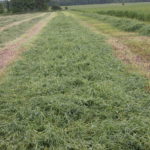
While it is always very tempting to cut some alfalfa in the fall, the decision should weigh the immediate need for forage against the increased risk of alfalfa winterkill and reduced yields next spring. The Critical Fall Harvest Period for alfalfa is the 6-week period preceeding the average date of killing frost. Not cutting during this rest period allows alfalfa plants to re-grow and build up sufficient root reserves to survive the winter and grow more aggressively in the spring. When cut early in the period, the alfalfa will use the existing root reserves for regrowth, “emptying the tank”. Later in the period, the alfalfa uses photosynthesis to produce carbohydrates and stores them as root reserves, “refilling the tank”. The Critical Fall Harvest Period begins as early as August 10th in northern Ontario, August 25 – 30th for eastern and central Ontario, and September 4th in the southwest. However, it is difficult to predict when that killing frost will actually occur. Cutting in the middle of the Critical Period is higher risk than cutting at the beginning or end.
We frequently see fields with disappointing 1st-cut yields where 4th cut was taken the preceeding fall. Even when winterkill does not occur, the extra yield harvested during the critical harvest period is typically offset by reduced 1st-cut yield the following spring. Some areas of the province, such as the Ottawa Valley, are at significantly higher risk. Fields with older stands, a history of winterkill, low potassium soil tests, low pH, poor drainage, or insect and disease pressure are at increased risk of winterkill and are poor candidates for fall harvesting. Aggressive cutting schedules with cutting intervals of less than 30 days between cuts increases the risk of winterkill, while intervals over 40 days (allowing flowering), reduces the risk.
If fall harvest must be done, risk of winterkill can be reduced (but not eliminated) by cutting towards the end of alfalfa growth, close to a killing frost. Leaving at least 6 inches of stubble will help trap snow to insulate the alfalfa crowns during cold weather. Sufficient top growth is required to hold snow that helps insulate overwintering crowns against cold temperature damage and frost heaving. Stubble will also protrude through winter ice sheeting, should that occur. After a killing frost, alfalfa feed value will decline, as leaf loss occurs and rain leaches nutrients quickly.
www.omafra.gov.on.ca/english/crops/facts/91-072.htm.